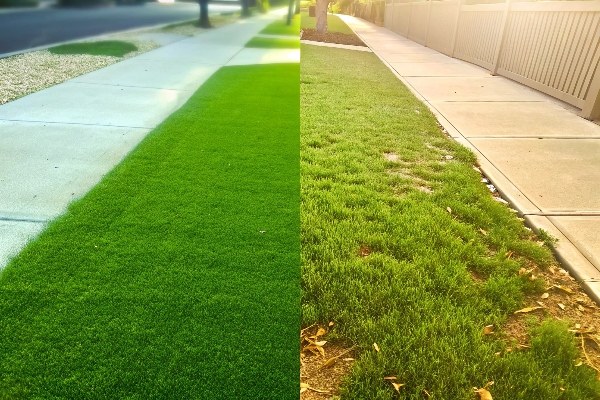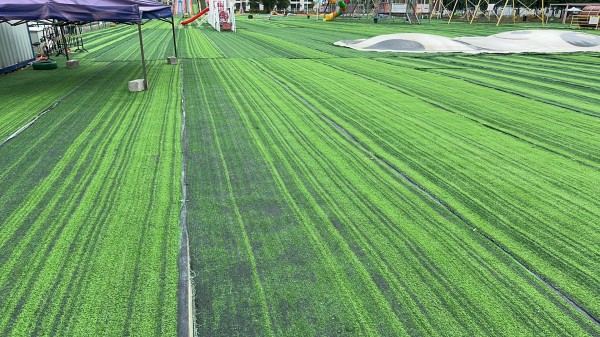Worried your new lawn will disrupt neighborly peace? Bad feelings next door are a real headache. Understanding their concerns is the key to avoiding conflict and enjoying your yard.
Fake grass can sometimes make neighbors mad, but it’s not inevitable. Their concerns usually stem from how it looks, its environmental impact, or safety. Choosing a quality product and good installation can prevent most issues.

I’ve been in the artificial turf industry for a long time. I have seen beautiful installations that everyone in the neighborhood admires. I have also heard the horror stories of installations gone wrong that become local eyesores. The difference often comes down to understanding the common complaints people have against fake grass before you even start. Let’s dig into why some people have such strong opinions about it. It is important to know what you might face so you can be prepared.
Why do people hate fake grass?
You’re excited about artificial turf, but negative opinions make you hesitate. This doubt is stressful. Understanding the specific criticisms helps you make a confident, well-informed choice.
The main reasons people dislike fake grass are its appearance, environmental impact, and surface heat. A shiny, plastic look is a common complaint, along with worries about microplastics and how hot it gets in the sun. Poor quality can also hurt property values.

Let’s break down the common objections I’ve heard over the years. As an engineer, I find it helpful to categorize these issues to address them properly. People’s concerns are not just about one thing; they usually fall into a few specific areas.
Aesthetic Concerns
The most immediate complaint is often about the look. Early generations of artificial grass were notoriously bad. They were shiny, had a single-tone green color, and looked more like a plastic carpet than a lawn. It screamed "fake." This is the image many people still have in their minds. Modern, high-quality turf has come a long way since then. We now use multiple shades of green and beige yarn, different blade shapes to reduce shine, and even a brown "thatch" layer woven into the base to mimic the look of real, healthy grass. A cheap product will always look cheap, and that is what sticks in people’s minds and creates a bad reputation.
Environmental and Practical Worries
This is a big one. People worry about the materials used, what happens at the end of the product’s life, and its effect on the local ecosystem1. Here’s a quick breakdown of the most frequent points I hear.
| Concern | The Issue | The Counterpoint / Solution |
|---|---|---|
| Plastic Use | The turf is a petroleum-based plastic product. | A high-quality turf lasts 15-20 years, reducing frequent replacement. Look for products made with recycled materials. |
| Heat Island | The surface can get hotter than natural grass. | Lighter-colored sand infill can reduce heat. A light spray with a hose also cools it down instantly on hot days. |
| Water Runoff | A non-permeable surface can increase runoff. | Professional installation requires a permeable sub-base, allowing water to drain through, often better than on compacted soil. |
| Ecosystem | It does not support worms, bugs, or soil life. | This is true. It is a sterile surface. It’s best used in areas where grass already struggles to grow, not to replace a healthy garden. |
Understanding these real concerns helps you choose a product and an installation method that minimizes the downsides. It is all about being a responsible owner and addressing the problems head-on.
Why is artificial grass being banned?
You hear about bans on artificial turf and it’s alarming. This news creates uncertainty and makes you worry about your investment. Knowing the exact reasons behind these bans clarifies the situation.
Bans on artificial grass are typically local, not widespread. They are driven by environmental concerns like microplastic shedding, increased surface heat2, and potential for water runoff3. Cities also cite the loss of natural habitat for insects and soil organisms as a key reason for these restrictions.

The word "ban" sounds scary, but it’s important to know this is not happening everywhere. These are usually decisions made by specific cities or homeowner associations (HOAs). In my experience helping clients navigate these rules, these decisions come from a few core concerns that are managed on a large, community-wide scale.
Microplastics and Pollution
This is the number one reason cited by environmental groups and city councils. When they talk about microplastics4, they are referring to two things: tiny pieces of the grass fibers breaking off over time due to sun and foot traffic, and the infill material (like crumb rubber) washing away into drains. These small particles can get into waterways and the wider environment. This is why choosing a durable, high-quality turf with a strong UV-resistant coating is so important. A well-made product sheds far less. Also, using organic or mineral infills like sand or cork instead of crumb rubber completely eliminates that specific source of pollution.
Urban Planning and Environmental Impact
City planners have to look at the big picture. They must manage things like city-wide temperatures and stormwater systems. Here’s how artificial turf fits into their calculations:
- The Heat Island Effect: In a city full of heat-absorbing concrete and asphalt, adding more non-porous surfaces can raise the local temperature. This is a valid concern, especially in very hot climates and dense urban areas.
- Stormwater Management: If hundreds of homes install turf improperly with a sealed, non-permeable base, it could overwhelm city storm drains during a heavy rainstorm. This is why I always tell my customers that a professional installation with a proper drainage base is not optional—it is essential for the system to function correctly and responsibly.
- Loss of "Green Space": From a city planning perspective, a "green space" is one that supports life. Artificial turf does not do that. This is why some bans are specifically focused on front yards or public-facing areas, while backyards are often left to the owner’s discretion.
These bans are not a simple "hate" for the product. They are policy decisions based on managing environmental risks on a large scale.
Conclusion
Ultimately, avoiding neighbor issues comes down to one thing: thoughtful choices. A high-quality, well-installed lawn that addresses environmental concerns will look great and keep the peace.
-
Explore the effects of artificial turf on local wildlife and soil health. ↩
-
Learn about the heat retention properties of artificial turf and how it compares to natural grass. ↩
-
This link will explain how artificial turf can impact stormwater management and runoff issues. ↩
-
Discover the implications of microplastics from artificial turf on the environment and health. ↩
_画板-1.png)
_画板-1.png)